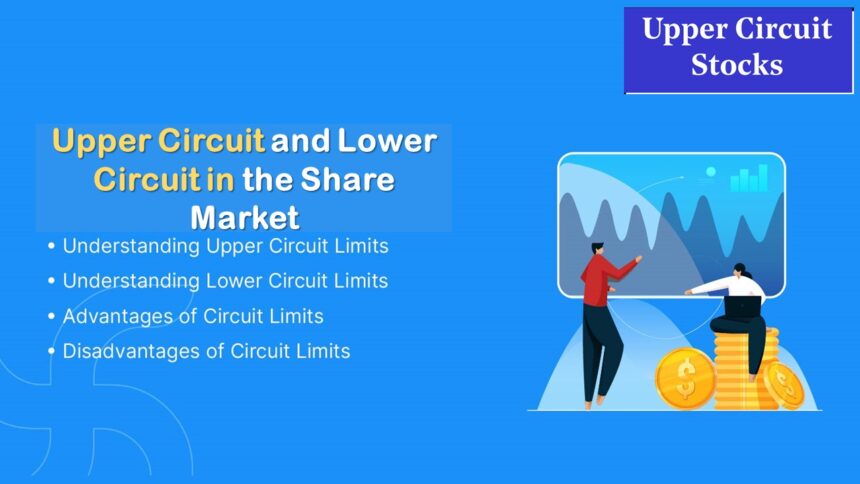Upper Circuit and Lower Circuit in the Share Market:In the stock market, the prices of shares can fluctuate significantly during the trading session. To protect investors from excessive volatility and maintain market stability, stock exchanges have implemented mechanisms known as “upper circuit” and “lower circuit” limits.
What is an Upper Circuit? (Upper circuit meaning)
The upper circuit is the maximum price level that a stock is allowed to reach during a trading session. This limit is set by the stock exchanges based on the previous day’s closing price of the stock. For example, if at the previous day a stock closed at ₹100 then its upper circuit price may be set at ₹102 ( 2% increase).
When a stock hits its upper circuit, it means that the demand for the stock has overwhelmed the available supply, causing the price to surge rapidly. At this point, the stock exchange will temporarily halt trading on the stock to prevent further upward movement in its price. This halt allows traders and investors to reassess the situation and make informed decisions.
The upper circuit serves several purposes:
- Curbing Excessive Volatility: By limiting the maximum price movement, the upper circuit helps to prevent panic-driven buying and speculative bubbles that can lead to sudden and sharp price increases.
- Protecting Investors: The upper circuit protects investors, especially retail investors, from getting caught in a frenzy of buying at inflated prices, which could result in significant losses if the stock price corrects later.
- Maintaining Market Stability: The upper circuit contributes to the overall stability of the stock market by ensuring that prices do not fluctuate excessively, which could otherwise lead to a loss of investor confidence.
What is a Lower Circuit?
The lower circuit, on the other hand, is the minimum price level that a stock is allowed to reach during a trading session. This limit is also set by the stock exchanges based on the previous day’s closing price of the stock. For example, if a stock closed at ₹100 the previous day, its lower circuit price may be set at ₹98 (a 2% decrease).
When a stock hits its lower circuit, it means that the supply of the stock has overwhelmed the available demand, causing the price to plummet rapidly. At this point, the stock exchange will temporarily halt trading on the stock to prevent further downward movement in its price.
Read this also:- NVIDIA’s Stock Sees Continued Growth and Strong Financial Performance
The lower circuit serves several purposes:
- Preventing Panic Selling: By limiting the maximum price decline, the lower circuit helps to prevent panic-driven selling that could lead to a downward spiral in the stock price.
- Protecting Investors: The lower circuit protects investors, especially those who hold the stock, from incurring significant losses due to a sudden and sharp drop in the stock price.
- Maintaining Market Stability: The lower circuit, like the upper circuit, contributes to the overall stability of the stock market by ensuring that prices do not fluctuate excessively, which could otherwise lead to a loss of investor confidence.

Differences between Upper Circuit and Lower Circuit
The key differences between upper circuit and lower circuit are as follows:
- Purpose: The upper circuit is designed to limit the maximum price increase of a stock, while the lower circuit is designed to limit the maximum price decrease.
- Calculation: The upper circuit and lower circuit both are calculated based on the previous day’s closing price of the perticular stock. The specific percentage may increase or decrease from one stock to another.
- Trigger: When a stock reaches its upper circuit, it indicates a high demand for the stock, with more buyers than sellers. Conversely, when a stock reached to its lower circuit that means it indicates a high supply of the stock with more sellers than buyers.
- Market Halt: When a stock hits either its upper or lower circuit, the stock exchange will temporarily halt trading on the stock to allow traders and investors to reassess the situation.
- Duration of Halt: The duration of the trading halt may vary depending on the magnitude of the price movement and the time of the day when the circuit is triggered.
Importance of Understanding Circuit Limits
It is crucial for investors to understand the concept of upper circuit and lower circuit in the stock market. It helps them to:
- Gauge Market Sentiment: Observing the stock’s behavior concerning its circuit limits can provide insights into the overall market sentiment and the level of investor demand or supply for the stock.
- Manage Risk: Knowing the circuit limits can help investors make informed decisions about their trading and investment strategies, allowing them to better manage their risk exposure.
- Anticipate Price Movements: Anticipating when a stock may hit its circuit limits can assist investors in timing their entry and exit points more effectively.
- Maintain Market Stability: The circuit breaker mechanism, which is triggered when a stock hits its upper or lower circuit, helps to maintain overall market stability and prevent excessive volatility.
In conclusion, the upper circuit and lower circuit are essential mechanisms in the stock market that aim to protect investors and maintain market stability. By understanding these concepts, investors can make more informed decisions and navigate the dynamic stock market environment more effectively.

